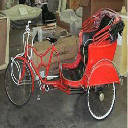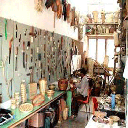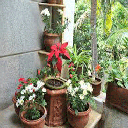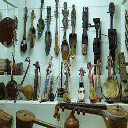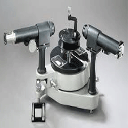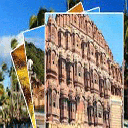A city of many dimensions is what befits a description of Allahabad. In addition to being a major pilgrimage centre, the city has played an important part in the formation of modern India. Hindu mythology states that Lord Brahma, the creator god, chose a land for 'Prakrishta Yajna'. This land, at the confluence of three holy rivers - Ganga, Yamuna and Saraswati, blessed by gods, came to be known as 'Prayag' or 'Allahabad'. Foreseeing the sanctity of the place, Lord Brahma also called it as 'Tirth Raj' or 'King of all pilgrimage centres.' The Scriptures - Vedas and the great epics - Ramayana and Mahabharata, refer to this place as Prayag. Centuries followed. Allahabad became the headquarters of North Western Provinces, after being shifted from Agra. Well preserved relics of the British impact includes the Muir College and the All Saints Cathedral. Many important events in India's struggle for freedom, took place here - the emergence of the first Indian National Congress in 1885, the beginning of Mahatma Gandhi's non-violence movement in 1920. This confluence of history, culture and religion makes Allahabad, a unique city. Area : 63.07 Sq. km. Population : 49,41,510 (2001 census) Altitude : 98 meters above sea level. Season : November - February Clothing (Summer) : Cottons (Winter) : Woollens Language : Hindi, English, Urdu. Festivals : Magh Mela, Kumbh Mela, Ardh Kumb Mela, Dussehra,Ganga water Raily (water Sports),Triveni Mahotsava etc. Local Transport : Taxis, Buses, Rikshaws. STD Code : 0532
Sangam Around 7 km from Civil Lines, overlooked by the eastern ramparts of the fort, wide flood plains and muddy banks protrude towards the sacred Sangam. At the point at which the brown Ganges meets the Greenish Yamuna, pandas (priests) perch on small platforms to perform puja and assist the devout in their ritual ablutions in the shallow waters. Beaches and ghats are littered with the shorn hair of pilgrims who come to offer pind for their deceased parents. Boats to the Sangam, used by pilgrims and tourists alike, can be rented at the ghat immediately east of the fort, for the recommended government rate of Rs 30 per head. However, most pilgrims pay around Rs 60 and you can be charged as much as Rs 150. Official prices for a whole boat are between Rs 100 and Rs 120 but can soar to more than Rs 250 during peak seasons. On the way to the Sangam, high-pressure aquatic salesmen loom up on the placid waters selling offerings such as coconuts for pilgrims to discard at the confluence. Once abandoned, the offerings are fished up and sold on to other pilgrims – a blatant if efficient form of recycling. The sacred Sangam is the confluence of three of the holiest rivers in Hindu mythology – Ganga, Yamuna and the mythical Saraswati. At the Sangam, the waters of the Ganges and the Yamuna can be distinctly seen to merge into one. It is during the Kumbh/Ardh Kumbh that the Sangam truly comes alive … attracting the devout from all across the country. The holy Sangam is the site for Annual Magha Mela/Ardh Kumbh/Kumbh Mela. Boats are available for visitors. Kumbh Mela Hindus traditionally regard river confluences as auspicious places, more so the the Sangam at Allahabad, where the Yamuna and the Ganges meet the River of Enlightenment, the mythical Saraswati. According to legend, Vishnu was carrying a kumbh (pot) of amrita (nectar), when a scuffle broke out between the gods, and four drops were spilled. They fell to earth at the four tirthas of Prayag, Haridwar, Nasik and Ujjain (tirtha means "ford of a river") a place where the devout can cross from this finite world into divine celestial realms. The event is commemorated every three years by the Kumbh Mela, held at each tirtha in turn; the Sangam is known as Tirtharaja, the "King of Tirthas", and its Mela, once every twelve years, is the greatest and holiest of all. The Maha Kumbh Mela - the "Great" Kumbh Mela - is the largest religious fair in India, attended by literally millions of rejoicing the vast floodplains and river banks adjacent to the confluence are overrun by pilgrims, tents, organized in almost military fashion by the government, the local authorities and the police. The mela is especially renowned for the presence of an extraordinary array of religious ascetics - sadhus and mahants - enticed from remote hideaways in forests, mountains and caves. Once astrologers have determined the propitious bathing time or Kumbhayog, the first to hit the water are legions of Naga Sadhus or Naga Babas,who cover their naked bodies with ash, and wear hair in long dreadlocks. The sadhus, who see themselves as guardians of the faith, approach the confluence at the appointed time with all the pomp and bravado of a charging army. The next Maha Kumbh Mela is due to take place in 2013. Allahabad Fort The massive fort built by emperor Akbar in 1583 A.D., the fort stands on the banks of the Yamuna near the confluence site. In its prime, the fort was unrivalled for its design, construction and craftsmanship. This huge, majestic fort has three magnificent galleries flanked by high towers. At present is used by the army and only a limited area is open to visitors.The magnificent outer wall is intact and rises above the water'’edge. Visitors are allowed to see the Ashokan Pillar and Saraswati Kup, a well, said to be the source of the Saraswati river and Jodhabai Palace. The Patalpuri temple is also here. So is the much revered Akshaya Vat or immortal Banyan tree. Patalpuri Temple Within this underground temple, inside the fort, lies the Akshaya Vat – or the immortal tree. Believed to have been visited by Lord Rama, the temple was also seen by the famous Chinese traveller and writer Hiuen Tsang during his visit to this place. Ashoka Pillar This gigantic Ashoka pillar, of polished sandstone stands 10.6 meters high, dating back to 232 B.C. The pillar has several edicts and a Persian inscription of Emperor Jahangir inscripted on it, commemorating his accession to the throne. Akshaya Vat The immortal tree within the Patalpuri temple, has found mention in the description of several ancient scriptures, writers and historians. The tree stands in a deep niche above an underground shaft, which is said to lead to Triveni. Visitors need permission to visit the Fort, Patalpuri Temple, Ashoka Pillar and AkshayaVat from Commandant, Ordinance Depot, Fort, Allahabad. Phone: 2504735-36, Extn. 213.





